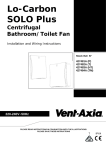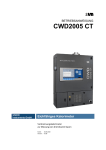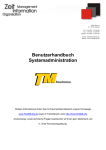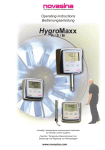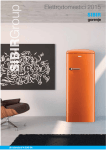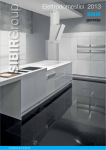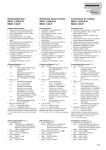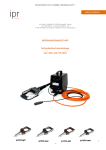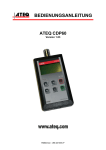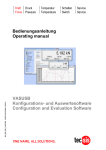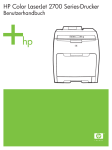Download Bedienungsanleitung CaliBox 200
Transcript
Bedienungsanleitung CaliBox 200 Diffenzdruck Kalibrator/Messgerät zur Kalibrierung und Prüfung von statischen und dynamischen Luftdifferenzdruck-Messinstrumenten Messbereich 0 bis 200 Pa www.novasina.com -1- English © by Novasina AG 2011 Technical data subject to modification Technische Änderungen vorbehalten Printed in Switzerland -2- Inhaltsverzeichnis Produkt Beschreibung ............................................................................................................. 4 Lieferumfang............................................................................................................................ 4 Sicherheit................................................................................................................................. 4 Gerätebeschrieb ...................................................................................................................... 5 Inbetriebnahme........................................................................................................................ 6 Kalibrierung im Calibrator Modus ............................................................................................ 7 Kalibrierung im Indicator Modus .............................................................................................. 8 Konfiguration mittels Software ................................................................................................. 8 Systemmeldungen ................................................................................................................... 9 Unterhalt und Support ............................................................................................................. 9 Zubehör ................................................................................................................................... 10 Technische Daten ................................................................................................................... 10 Ersatzteile ............................................................................................................................... 10 Deutsch Werkseinstellungen ................................................................................................................. 10 -3- 1. Produkt Beschreibung Vielen Dank, dass Sie sich für dieses Novasina Qualitätsprodukt entschieden haben. Wir danken für Ihr Vertrauen. Der mobile Differenzdruck Kalibrator CaliBox 200 von Novasina ist ein universelles Kalibrier- und Messgerät für die Überprüfung von statischen (Membran) sowie dynamischen (Massenfluss) LuftDifferenzdruck Messgeräten mit Messbereich von 0 bis 200 Pa. Das Gerät kann in Reinräumen eingesetzt werden und wird mittels Akku betrieben. Eine externe Speisung entfällt somit und eine grösstmögliche Mobilität ist gewährleistet. Die CaliBox 200 ist ein hochpräziser Druckgenerator sowie Messgerät und erzeugt einen genauen und kontinuierlichen Luftstrom, welcher sich über einen Drehregler einstellen lässt. Dank automatischem Nullpunktabgleich erreicht das Gerät eine sehr hohe Reproduzierbarkeit und Langzeitstabilität. Deutsch Nebst Differenzdruck Erzeuger ist dieser Kalibrator auch ein vollwertiges Messinstrument, das sogar als akkreditiertes Referenzmessgerät eingesetzt werden kann. Besondere Eigenschaften: • Universell einsetzbar für statische und dynamische Differenzdruck-Messumformer Der Lieferumfang der CaliBox 200 beinhaltet: • Mobiler Differenzdruck Kalibrator im robusten Kunststoffkoffer mit integriertem „LiFe“ Akku • Externes „LiFe“ Ladegerät mit 230 V Stecker • RS-232 Konfigurationskabel • 2m Schlauch ID 8mm mit Anschlussstutzen • 2m Schlauch ID 5mm mit Anschlussstutzen • 2m Schlauch ID 4mm mit Anschlussstutzen • 2 x 2m Schlauch ID 4mm • 2 x Lösegabeln für Druckstutzenpfropfen • 4 x Stutzen für Schlauch ID Reduktion 8/5mm • Werkskalibrierzertifikat mit 11 Kalibrierpunkten über gesamten Arbeitsbereich von 0 bis 200 Pa • CD mit PascalTool WIN GerätekonfigurationsSoftware und Bedienungsanleitung CaliBox 200 • Gedruckte Bedienungsanleitung CaliBox 200 Überprüfen Sie die Vollständigkeit des Lieferumfangs. Unvollständige Lieferungen können von Ihrer Novasina Vertretung umgehend ergänzt werden. 3. Sicherheit • ACHTUNG! Das Gerät enthält einen Akku vom Typ „LiFe“ mit hoher Energiekapazität. Laden Sie das Gerät immer unter Aufsicht und nur mit dem mitgelieferten Ladegerät auf. • Hohe Genauigkeit und Stabilität dank automatischem Nullpunktabgleich • Aufgrund des eingebauten Akkus gelten für den Transport spezielle Richtlinien. • Als Kalibrator sowie als Messgerät einsetzbar (auch zertifizierbar) • Dieses Gerät hat das Werk in sicherheitstechnisch einwandfreiem Zustand verlassen und darf unter keinen Umständen manipuliert werden. Beachten Sie die Hinweise und Warnschilder auf dem Instrument und in der Bedienungsanleitung. ACHTUNG! Aufgrund des internen Energiespeichers besteht bei Kurzschlüssen Brandgefahr! • Akkubetrieben mit langer Betriebszeit • Einfache Justage über PascalTool Win Software • Integrierte skalierbare analoge Ausgänge • Die CaliBox 200 wurde für die Überprüfung von statischen- und dynamischen Differenzdruck Messinstrumenten in Reinluftumgebung entwickelt und sollte nur für diesen Zweck und innerhalb der angegebenen Spezifikationen und Betriebsbedingungen eingesetzt werden. Bei unsachgemässer Benutzung wird vom Hersteller/Lieferant für entstandene Schäden nicht gehaftet. Das Risiko trägt allein der Betreiber. 2. Lieferumfang • Die Handhabung des Kalibrators setzt entsprechend geschultes Fachpersonal voraus. Lesen Sie diese Bedienungsanleitung deshalb sorgfältig durch. -4- • Die CaliBox 200 ist nicht für den Einsatz in explosionsgefährdeten Räumen geeignet. dus (kurz drücken); fürs Ein-/Ausschalten des automatischen Nullpunktabgleichs (lang drükken). Kalibriermodus (Calibrator): Der im Inneren der CaliBox 200 generierte Druck wird über die 2 Stutzen (Calibrator/Dynamic/Static) nach aussen geleitet und auf dem Display angezeigt, die Measure LED leuchtet rot, die Indicator LED ist aus. • Nur der fachgerechte Umgang mit dem Kalibrator sowie entsprechende Messtechnikkenntnisse erlauben die richtigen Rückschlüsse auf die effektive Messgenauigkeiten und Toleranzen. Messmodus (Indicator): Der Differenzdruck wird von aussen auf die 2 Stutzen (Indicator/Static+/ Static-) angelegt und auf dem Display angezeigt, die Measure sowie Indicator LED leuchten rot. • Der Kalibrator sollte periodisch überprüft werden. Dies kann intern oder durch unabhängige akkreditierte Messstellen (SCS/DKD usw.) erfolgen. Ein-/Ausschalten der automatischen Nullung: Werden beide Tasten gedrückt gehalten schaltet die automatische Nullpunktjustierung aus. Das Display zeigt kurzzeitig AZ OFF an und die Run/Error LED blinkt orange. Die CaliBox 200 arbeitet jetzt ohne automatische Nullung. Bei erneutem längerem Drücken beider Tasten wird die Funktion wieder eingeschaltet und dabei auch gleich eine Nullung durchgeführt. Das Display zeigt kurz AZ ON an und die Run/Error LED blinkt wieder grün. • Verwenden Sie ausschliesslich Originalzubehör und Originalersatzteile von Novasina. • Das Öffnen oder Umbauen des Kalibrators ist zu unterlassen und zieht die sofortige Aufhebung der Garantieleistung mit sich. Dies gilt auch für den Austausch des Akkus. 4. Gerätebeschrieb Hauptschalter / Druckregler: • Hauptschalter (Power On/Off) zum Ein- und Ausschalten des Geräts. • Drehregler mit Arretierung (Pressure Adjustment) zur Einstellung des generierten Differenzdruckes. Power On/OFF • Taste (Park Zero Adjustment/Measure) mit Doppelfunktion; fürs Umschalten zwischen Normalbetrieb/Parken (kurz drücken); für den manuellem Nullpunktabgleich (lang drücken). Parkmodus: Der Normalbetrieb im Kalibrier- oder Messmodus kann jederzeit durch kurzes Drücken dieser Taste unterbrochen werden. Die Membran des Messelements wird dadurch kurzgeschlossen. Die Measure LED geht dabei aus. Bemerkung: Die Aktivierung dieser Funktion empfiehlt sich vor der manuellen Nullung im Messmodus. Druckeinstellung Drucktasten für Betriebmodus Auswahl: • Die CaliBox 200 verfügt über 2 Tasten, mit denen sämtliche Betriebsmodi eingestellt werden können. TASTE : Calibrator Indicator TASTE : Messung Park Zero Adjust • Taste (Calibrator/Indicator) mit Doppelfunktion; fürs Umschalten zwischen Kalibrier-/ Messmo- Manueller Nullpunktabgleich: Bei längerem Drücken dieser Taste wird die manuelle Nullung durchgeführt werden. Dabei spielt es keine Rolle in welchem Modus sich das Gerät befindet. Auf dem Display wird kurzzeitig ZERO CAL angezeigt. Bemerkung: Beim Aus-/Wiedereinschalten wird der Betriebsmodus auf Werkseinstellung zurückgesetzt. Anschlussstutzen Druckerzeuger: • Auf der Frontplatte der CaliBox 200 befinden sich 4 Stutzen, von denen jeweils 2 für den Betrieb als Druckerzeuger/Kalibrator (Calibrator) und 2 für die Nutzung als Differenzdruck ReferenzMessgerät (Indicator) gebraucht werden. • Die Anschlüsse für den Betrieb als Druckerzeuger/Kalibrator unterscheiden sich zwischen -5- Deutsch • Dort, wo auftretende Fehler oder Fehlfunktionen grosse Material- oder Personenschäden verursachen können sind zusätzliche Schutz- und Sicherheitsvorkehrungen zu treffen, so dass im Fehlerfall ein sicherer Betriebszustand gewährleistet wird (z.B. Grenzwertschalter). dynamische (Dynamic) und statische (Static) Kalibrierung, welche jeweils für Massenflussbzw. für Membran-Differenzdruck Messgeräte benötigt wird. Indicator Static + Calibrator Dynamic Output + Indicator Static - Analoger Signalaussgang: Über diese Schnittstelle wird das aktuelle Messsignal des in der CaliBox 200 integrierten Messgeräts in 0/2...10VDC ausgegeben. Zur Erhöhung der Auflösung kann es entsprechend skaliert und zudem justiert werden. Diese Einstellungen können über die mitgelieferte PascalTool WIN Konfigurationssoftware durchgeführt werden. Bemerkung: Das analoge Signal kann z.B. für den Calibrator Anschluss eines Datenschreibers genutzt werden. Static Output + Akku-Ladebuchse: • Akku Ladebuchse (Batt Charger) zum Einstecken des XLR-Steckers des externen Ladegeräts. Anschluss für dynamische Kalibrierung: Dieser Druckanschluss dient der Kalibrierung von Prüflingen mit Massenfluss Messprinzip, d.h. Geräte, die den dynamischen Differenzdruck messen und einen kontinuierlichen Luftfluss benötigen. Für solche Instrumente empfiehlt Novasina den mitgelieferten Schlauch mit ID 8 mm zu verwenden, da sonst der Druckabfall im Schlauch zu gross wird. Deutsch Bemerkung: Bei der Kalibrierung von Massenfluss Messgeräten ist infolge des Druckabfalls im Schlauch, dessen max. Länge eingeschränkt. Basierend auf einen ID 8mm ergibt sich eine maximale Länge von 30 m. Bei kleineren Schlauch ID verringert sich diese Maximallänge erheblich. Anschluss für statische Kalibrierung: Dieser Druckanschluss dient der Kalibrierung von Prüflingen mit Membran Messprinzip, d.h. Geräte, die den statischen Differenzdruck messen. Hier verwendet man mit Vorteil einer der mitgelieferten Schläuche mit ID 5 mm oder 4 mm. Bemerkung: Beim statischen Druck hat weder der Schlauch-Innendurchmesser noch die -Länge einen Einfluss auf den generierten Druck. Analoger Signalausgang: • Analoger Signalausgang des aktuellen gemessenen und angezeigten Messwerts (Analogue OutputVDC/Pressure Value) Ladebuchse: Über diese Buchse wird der eingebaute Akku innerhalb einer Ladezeit von < 3 Std. wieder zu 100% aufgeladen. EMV Hinweise: 1. Das Gerätedesign ist so konzipiert, dass alle Emissionen/Imissionen im Rahmen der gesetzlichen EMV-Normen und Vorschriften erfüllt werden. 2. Störungsaussendende Leitungen im Bereich des temporären Standortes der CaliBox 200 sind zu meiden. 5. Inbetriebnahme Laden des Akkus: Die CaliBox 200 wird immer mit voll aufgeladenem Akku ausgeliefert und kann sofort in Betrieb genommen werden. Die Akku-Betriebszeit bei voller Ladung beträgt je nach Verwendung min. 24 bis max. 48 Stunden. Der LiFe Akku kann jederzeit wieder voll aufgeladen werden, d.h. er muss nicht zwingend zuerst voll entladen werden. Die Ladekapazität verringert sich dabei nicht. Wichtig: Beim Aufladen darf ausschliesslich das mitgelieferte Ladegerät verwendet werden. Die CaliBox 200 darf während des Ladevorgangs nicht -6- Zustandsanzeige Ladegerät : • LED 1 leuchtet rot -> Gerät ON / LED 1 aus -> Gerät OFF. • LED 2 leuchtet rot -> Laden ON / LED 2 leuchtet grün -> Laden OFF bzw. Akku geladen. Vorgehensweise beim Laden: 1. Das Ladegerät über IEC-Dose am Netz mit 110...230VAC anschliessen -> LED1 leuchtet rot, LED 2 leuchtet grün. 2. Ladegerät über XLR-Stecker mit Calibox verbinden -> LED1 und LED 2 leuchten rot. 3. Ladevorgang abwarten bis LED 2 grün leuchtet (Akku vollständig geladen). 4. XLR-Stecker aus CaliBox 200 ziehen. 5. Netzkabel aus IEC-Dose ziehen. Bemerkung: Die vollständige Akkuladezeit bei leerem Akku beträgt < 3Std. Tipps zur Akkupflege: • Wegen der Selbstentladung sollte der Akku nur voll geladen eingelagert werden. • Zum Schutz vor Tiefentladung sollte der Akku jährlich min. einmal voll geladen werden. 6. Kalibrierung im Calibrator Modus: (mit Druckgenerator) Anschliessen der Prüflinge: Vor dem Anschliessen des Prüflings, sollte dessen Messprinzip abgeklärt werden. Man unterscheidet dynamische (mit Massenfluss) und statische (mit Membran) Messverfahren. Mit der CaliBox 200 können alle Prüflinge kalibriert werden. Je nach Messprinzip werden diese am Druckanschluss Dynamic oder Static angeschlossen. Vorgehen bei Massenfluss Geräten: 1. Entfernen des Verschlusspfropfens beim Druckstutzens (Dynamic) ->Lösegabel ansetzen und mit einer Kippbewegung nach unten drücken. 2. Schlauchstutzen bis zum Einrasten in Druckstutzenöffnung einstecken. 3. Schlauch eingangsseitig (positive Druckseite) an Prüfling anschliessen. Gegebenenfalls mitgelieferten Gummi-Reduktionsstutzen ID 8/5mm am Schlauchende einschieben. Ausgangsseitig (negative Druckseite) idealerweise nichts an den Prüfling anschliessen 4. Elektronische Kompensation der gesamten Schlauchlänge. Diese besteht aus der Länge zwischen Kalibrator und Prüfling (200 cm) + Länge des im Innern der CaliBox 200 eingebauten Schlauchs (24 cm) + evtl. Länge des ausgangseitig angeschlossenen Schlauchs. Diese Länge wird mittels der PascalTool WIN Software auf den Prüfling geschrieben und somit bei der Messung kompensiert. Dazu muss der Prüfling über das mitgelieferte Datenkabel an einen Rechner angeschlossen und Software gestartet werden. Danach Read data drücken (die Verbindung zum Prüfling wird erstellt). Anschliessend die Registerkarte Environment auswählen und die Schlauchlänge eingeben. Abschliessend Write data drücken um die Daten auf den Prüfling zu schreiben (mehr Details siehe Kap. 8). Wichtig: Die Schlauchlänge muss zwingend kompensiert werden, da sonst der Druckabfall im Schlauch die Messung verfälscht. Die kompensierte Länge muss nach erfolgter Kalibrierung/Justierung unbedingt wieder auf den ursprünglichen Wert zurückgesetzt werden. Deshalb unbedingt die ursprünglich kompensierte Schlauchlänge for der Kalibrierung notieren. 5. Zusätzlich kann ein Referenz-Messgerät parallel an den Druckstutzen (Static/Output+) angeschlossen werden. Dabei sollte wie in Punkt 1 und 2 verfahren werden. Bemerkung: Die CaliBox 200 kann auch als Referenz-gerät zertifiziert werden. In diesem Fall entfällt Pkt 5. -7- Deutsch zugedeckt werden und es muss immer für eine ausreichende Belüftung gesorgt werden. Es gilt zu beachten, dass das Ladegerät nach dem Aufladen zuerst vom Gerät und anschliessend vom Netz getrennt wird! Lesen Sie vor der ersten Benutzung die beiliegende Ladegerät-Bedienungsanleitung sorgfältig durch! 6. Sicherstellen, dass sich die Calibox im Kalibriermodus befindet und dann den gewünschten Druck mit dem Drehregler einstellen. 7. Kalibrierung/Justierung durchführen. 8. Für weitere Druckpunkte Punkt 6/7 wiederholen. 9. Die ursprüngliche Schlauchlänge und ggf den neuen GAIN Wert mit Write data auf den Prüfling schreiben. 10.Bei Bedarf weitere Prüflinge kalibrieren. 11.Nach Abschluss der Arbeiten den Schlauch vom Prüfling und evtl. vom Referenz-Messgerät abziehen und Kalibrator ausschalten. 12.Die Schläuche mithilfe der Lösegabel von den Druckstutzen rausziehen. Dazu Gabel zwischen Schlauchende und Stutzenring einstecken, vertikal auf den Ring drücken und gleichzeitig Schlauch rausziehen. wie der Prüfling (Static/Output+) angeschlossen werden. Bemerkung: Die CaliBox 200 kann auch als Referenz-gerät zertifiziert werden. In diesem Fall entfällt Pkt 4. 5. siehe Massenfluss Messgeräte 6. siehe Massenfluss Messgeräte 7. siehe Punkt 8 Massenfluss Messgeräte 8. Siehe Punkt 10 Massenfluss Messgeräte 9. Siehe Punkt 11 Massenfluss Messgeräte 10.Siehe Punkt 12 Massenfluss Messgeräte 11.Siehe Punkt 13 Massenfluss Messgeräte 7. Kalibrierung im Indicator Modus: (ohne Druckgenerator) Bemerkung: Die Calibox 200 dient dabei als Referenz Messgerät (mit oder ohne akkreditierte Zertifizierung). Kalibrierung beginnen: Deutsch 13.Verschlusspfropfen bis zum Einrasten in die Stutzen einstecken und Schläuche im Deckel der CaliBox 200 verstauen. Vorgehen bei Membran Geräten: 1. Mittels T-Stück die Druckeingänge von Prüfling und CaliBox 200 (Static+) parallel verschlauchen. Dabei achten, dass beide Eingänge (positive Druckseite) zusammen verbunden werden. 2. Mittels T-Stück die Druckausgänge von Prüfling und CaliBox 200 (Static-) parallel verschlauchen. Dabei achten, dass beide Ausgänge (negative Druckseite zusammen verbunden werden. 3. Kalibrierung/Justierung durchführen. 1. Entfernen des Verschlusspfropfens beim Druckstutzens (Static Output+) ->Lösegabel ansetzen und Hebel mit einer Kippbewegung nach unten drücken. 2. Schlauchstutzen bis zum Einrasten in Druckstutzenöffnung einstecken. 3. Schlauch eingangsseitig (positive Druckseite) an Prüfling anschliessen. Nach Bedarf auch Ausgangsseite (negative Druckseite) anschliessen (Static Pressure-), dabei ist evtl. eine Verbindung mit einem T-Stück zum Referenzdruck (Atmosphäre) oder zur Referenzleitung nötig. Bemerkung: Bei der Kalibrierung im Feld wird in der Regel die Ausgangsseite (negative Druckseite) auf die Referenzleitung geführt. Bemerkung: Beim Kalibrieren von Membransensoren muss die Schlauchlänge zwischen Kalibrator und Prüfling NICHT kompensiert werden. Die CaliBox 200 kann mit der auf CD mitgelieferten PascalTool WIN Software konfiguriert und justiert werden. Diese läuft auf Rechnern mit Betriebssystem Windows 7, Vista, XP, 2000 und 98. 4. Zusätzlich kann ein Referenz-Messgerät am Druckstutzen (Dynamic/Output+) oder parallel über ein T-Stück am gleichen Druckstutzen -8- 4. Nach Abschluss der Arbeiten CaliBox 200 ausschalten, die Schläuche von den Stutzen abziehen und im Deckel verstauen. 8. Konfiguration mittels Software : Klinkenbuchse für Anschluss PascalTool WIN Bedienung der PascalTool WIN Software : Sobald die CaliBox 200 am Rechner angeschlossen und das Gerät eingeschaltet ist, kann die PascalTool WIN Software gestartet werden. Kurzanleitung: 1. Software starten -> Hauptfester geht auf 2. Aktivierung des COM-Ports (falls USB Schnittstelle benutzt wird). Dieses kann im Menü Options -> Preferences -> COM Port -> OK aktiviert werden. 3. Daten auslesen -> Read Data, danach werden folgende Gerätedaten des in der CaliBox 200 eingebauten Differenzdruck Messgeräts angezeigt - Instrument no.: Pascal-STV Z - Serial No.: XXXXXXX - dP range: 0...200Pa - Pressure: XXX.XXPa (akt. Messwert) Bemerkung: Falls eine Fehlermeldung erscheint, sollte ein anderer COM-Port ausgewählt werden. 4. Auswahl eines der folgenden Register für die Ausführung der gewünschten Funktion. - Measurement: Sensorjustierung mittels Einstellung des Gain Einstellung des TiefpassFilters für Glättung des aktuellen Messwertes - Analog Output: Skalierung des analogen Ausgangs Auswahl des Spannungs bereichs 0/2....10V Justierung des analogen Ausgangs mittels Einstel lung von Gain und Offset - LC Display: Auswahl der Messeinheit und Kontrast auf Anzeige 5. Nach erfolgter Konfiguration bzw. Einstellung jeweils auf Write Data drücken um die Daten auf das Gerät zu speichern. Bemerkung: Die PascalTool WIN Software bietet auch die Möglichkeit, die eingestellten Parameter zu mit einem Passwort zu schützen. Dieses kann in der Menüleiste unter Options -> Change protection code aktiviert werden. Die Geräteeinstellungen können auch ausgedruckt werden. Dies wird in der Menüleiste unter File mit der Funktion Print durchgeführt. PascalTool WIN bietet zudem auch ein Hilfe-programm. Die Help Funktion in der Menüleiste enthält alle wichtigen Informationen zur Bedienung und zu den Funktionen der PascalTool WIN Software. 9. Systemmeldungen AZ OFF AZ ON ZERO CAL Automatische Nullung aus Automatische Nullung ein Manuelle Nullung wird durchgeführt dP UNDERFLOW Druckerzeugung unter min. Messbereich (<= 5 Pa) dP OVERFLOW Druckerzeugung über max. Messbereich (> 200 Pa) NOVAS SELFCAL Durchführung der Selbstkalibrierung (Selbsttest beim Einschalten des Geräts) 10. Unterhalt und Support Unterhalt/Reinigung: Das Gerät bei Bedarf nur mit einem feuchten Tuch abwischen. Auf keinem Fall dürfen aggressive Reinigungsmittel verwenden werden! Akkreditierung & Rekalibrierung: Für eine nachträgliche Zertifizierung des Kalibrators durch ein akkreditiertes Labor, setzten Sie sich bitte mit Ihrem lokalen Novasina Vertriebspartner in Verbindung. Dieser wird Sie entsprechen unterstützen. -9- Deutsch Kurzanleitung Softwareinstallation: 1. CD in das Laufwerk des Rechners legen und im Window Explorer Laufwerk auswählen 2. Durchführung der Installation auf Rechner mit der Novasina_PascalTool WIN.exe Datei -> SETUP abschliessen. 3. Die PascalTool WIN wurde erfolgreich installiert Anschliessen des Rechners an die CaliBox 200: Das mitgelieferte Datenkabel (DB-9 zu Klinkenstecker), wird in die Klinkenbuchse (Interface), welche sich über dem Display befindet eingesteckt. Technischer Support: Melden Sie sich bei Fragen oder allfälligen Störungen bei Ihrem lokalen Novasina Vertriebspartner. Mehr Infos auf www.novasina.com. 11. Zubehör Es wird kein zusätzliches Zubehör benötigt. 12. Technische Daten Typ Artikel-Nr. Differenzdruck Arbeitsbereich / Messbereich Max. Auflösung Anzeige Messgenauigkeit bei 20°C Temperatureffekt Deutsch Offset drift Hysterese Messelement im Messgerät Max. zulässiger Überdruck Betriebstemperatur Umgebungsmedium Betriebsspannung Akkuladezeit Akkubetriebszeit bei voller Aufladung Analoge Ausgänge Genauigkeit der analogen Ausgänge Digitale Schnittstelle Abmessungen Gehäuse Schutzklasse geöffnet Schutzklasse geschlossen Gesamtgewicht Lager-Temperaturbereich CaliBox 200 260 0538 0 ... 200 Pa statisch und dynamisch 0.01 Pa typisch <= 0.15 Pa bzw. 0.08% FS (Full Scale = gesamter Messbereich) Einfluss Konstanttemperatur: typisch <= 0.03 Pa/°C bzw. 0.015% FS/°C Einfluss Temperaturänderung 10°C/h: typisch <=0.6 Pa bzw. 0.3% FS typisch <= 0.15 Pa / Jahr (automatischer Nullpunkt-Abgleich) typisch <= 0.15 Pa Piezoresistiver Membran-Differenzdruck Sensor -100...500 kPa 5...50°C nicht kondensierende, nicht korrosive Luft Akku 25.6V/10 Ah LiFe PO4 mit BMS < 3 Stunden > 24...48 Stunden 0/2 ... 10V (Last >= 10 kOhm) typisch 0.05% vom gesamten Messbereich (FS) RS 232 360 x 304 x 194 mm IP 30 IP 54 7.3 kg -10 ... + 60°C nicht kondensierend 13. Ersatzteile Bezeichnung Artikel Nr. Stutzen für Schlauch ID Reduktion 8/5mm 111 6332 14. Werkseinstellungen Anzeige AOUT : : 0... 200 Pa 0...10V Passwort Werksjustierung : : Deaktiviert Vorkalibriert mit Zertifikat - 10 - - 11 - Deutsch - 12 - Operating manual CaliBox 200 Differential pressure calibrator / measurement device for calibration and inspection of static and dynamic Air differential pressure measurement instruments Measurement range 0 to 200 Pa - 13 - - 14 - Table of contents Product description .................................................................................................................. 16 Scope of delivery ..................................................................................................................... 16 Safety ...................................................................................................................................... 16 Device description ................................................................................................................... 17 Initial operation ........................................................................................................................ 18 Calibration with calibrator mode .............................................................................................. 19 Calibration with indicator mode ............................................................................................... 20 Configuration with software ..................................................................................................... 20 System messages ................................................................................................................... 21 Maintenance and support ........................................................................................................ 21 Accessories ............................................................................................................................. 22 Technical data ........................................................................................................................ 22 Spare parts ............................................................................................................................. 22 English Factory settings ....................................................................................................................... 22 - 15 - 1. Product description Thank you for choosing this Novasina quality product. We thank you for your trust. The mobile differential pressure calibrator CaliBox 200 from Novasina is an universal calibration and measurement device for the inspection of static (membrane) as well as dynamic (mass flow) air differential pressure measurement instruments within the range of 0 to 200 Pa. This device can be used in clean rooms and laboratories on site and is powered by a battery. An external power supply is not necessary and thus a maximum mobility and versatility is granted. The CaliBox 200 is a highly accurate pressure generator and also a measurement device, which generates an accurate and stable continuous airflow, which is controlled by a rotary knob. Thanks to its auto-zeroing function it achieves a very high reproducibility and long term stability. In addition to a differential pressure generator this calibrator is also a professional measurement instrument, which can be even used as an accredited reference device. The scope of delivery of the CaliBox 200 contains: • Mobile differential pressure calibrator with robust plastic case and integrated „LiFe“ battery • External „LiFe“ charger with 230 V plug • RS-232 configuration cable • 2m hose inner diam.8mm with connection nozzle • 2m hose inner diam.5mm with connection nozzle • 2m hose inner diam.4mm with connection nozzle • 2 x 2m hose with inner diameter 4mm • 2 x plug removing bracket • 4 x nozzles for hose reduction i.d. 8/5mm • Factory calibration certificate with 11 calibration points over the working span of 0 to 200 Pa • CD containing the PascalTool WIN configuration software and operating manual for CaliBox 200 • Printed operating manual for CaliBox 200 Please check the completeness of the delivery. Incomplete deliveries can be completed by your local Novasina distributor. English Specific characteristics: • High versatility for static and dynamic differential pressure transducers • High accuracy and stability thanks to the autozeroing function • Usable as calibrator as well as measurement instrument and reference (with certificate) • Battery powered with extended running time • Easy calibration and adjustment with PascalTool WIN software • Integrated scalable analogue outputs 2. Scope of delivery 3. Safety • ATTENTION! The device contains a „LiFe“ battery type with energy capacity. Do only charge the device under supervision and only with the delivered charger. • Due to the integrated battery, special shipping rules must be considered for the CaliBox 200. • This device has left the factory in an impeccable status from the point of view of safety and must not be manipulated under any circumstances. Pay attention to the remarks and signs on the instrument and in the operating manual. ATTENTION! Because of the internal energy storage there is a danger of fire in case of a short-circuit! • The CaliBox 200 has been developed for the inspection of static and dynamic differential pressure measurement instruments in clean air environment and should be only used for such purposes respecting the indicated specifications and operation conditions. In case of inappropriate use the manufacturer/supplier declines any liability. The risk is only on the operator’s side. • The handling of this calibrator requires skilled - 16 - • Where occurrent failures or malfunctions might cause big damages on material or people additional safety precautions have to be taken to assure a safe status in case of failure (e.g. limit switch). • The CaliBox 200 is not suitable for potentially explosive processes and rooms. • Only a professional handling of the calibrator as well as a certain measurement technology know-how allow a correct interpretation of the real accuracy and tolerances. • The calibrator should be inspected and calibrated periodically. This can be performed internally or by an accredited laboratory (e.g. SCS, DKD, NIST, COFRAC etc.). • Use only original Novasina accessories and spare parts. • The opening and altering of the calibrator is strictly forbidden and revokes immediately the warranty. This means also the battery replacement. 4. Device description Main switch / pressure controller: • Main switch (Power On/Off) to switch on and off the device. • Rotary knob controller with lock (Pressure Adjustment) for pressure adjustment. Power On/OFF Measurement mode (Indicator): The differential pressure is carried from the outside to the 2 nozzles (Indicator/Static+/Static-) and is shown on the display, the Measure as well the Indicator LED flash red. Switching on/off the auto zeroing: If both buttons are kept pushed, the auto zeroing is switched off. The display shows briefly AZ OFF and the Run/ Error LED blinks orange. Now the CaliBox 200 works without auto zeroing function. If both buttons are kept pushed again the function is re-activated and a zeroing is performed immediately. The display shows briefly AZ ON and the Run/Error LED blinks green. • Button (Park Zero Adjustment/Measure) with double function; for switching between standard operation/park mode (push briefly); for manual zeroing (push long). Park mode: The standard operation in the calibration or measurement mode can be interrupted at any time by pushing briefly this button. In this mode the membrane of the sensor is bypassed. The Measure LED is switched off. Remark: The activation of this function is recommended prior to the manual zeroing in the measurement mode. Manual zeroing: If this button is pushed for a longer time, the manual zeroing is performed, independent from the actually selected mode. The display shows briefly ZERO CAL. Pressure adjustment Push-button for operation mode selection: Remark: When the device is switched off and on again, the operation mode is reset to factory settings. • The CaliBox 200 has 2 buttons, with which all available operation modes can be selected. BUTTON: Measure Park Zero Adjust • Button (Calibrator/Indicator) with double function; for switching between calibration/measurement mode (push briefly); for switching on/off the auto zeroing (push long). Calibration mode (Calibrator): The pressure generated inside the CaliBox 200 is carried outwards by the 2 nozzles (Calibrator/Dynamic/Static) and is shown on the display, the Measure LED flashes red, the Indicator LED is switched off. BUTTON : Calibrator Indicator Connection nozzles pressure generator: • There are 4 nozzles on the CaliBox 200 front panel of which 2 are for the operation as pressure generator/calibrator (Calibrator) und the other 2 are for the use as differential pressure reference measurement instrument (Indicator). • The nozzles for pressure generator/calibrator - 17 - English personnel. So, please read this operating manual carefully. operation are distinguished between dynamic (Dynamic) and static (Static) calibration, which are used for mass flow respectively for membrane differential pressure instruments. Indicator Static + Calibrator Dynamic Output + Indicator Static Calibrator Static Output + Analogue signal output: This interface provides the actual measurement signal in 0/2...10VDC of the measurement device integrated in the CaliBox 200. In order to obtain a higher resolution the signal can be scaled and also adjusted. These settings can be done using the delivered PascalTool WIN configuration software. Remark: The analogue signal can be used for the connection to an external device (e.g. data logger etc.) Battery charger socket: Connection for dynamic calibration: This pressure nozzle can be used for the calibration of instruments working with the mass flow measurement principle, which means devices detecting the dynamic differential pressure requiring a continuous air flow. For such instruments it is recommended to use the included hose with i.d. 8mm as otherwise the loss of pressure will be too big. English Remark: Due to the mass flow principle and the loss of pressure inside the hose, the max. hose length is limited to 30 m based on a hose with i.d. 8 mm. On smaller diameters the max length is reduced dramatically. Connection for static calibration: This pressure nozzle is used for the calibration of instruments working with the membrane measurement principle, which means devices, detecting the static differential pressure. In this case it is recommended to use the included hoses with i.d. 5 mm or 4 mm. Remark: In the case of static pressure there is neither an influence of the hose i.d. nor the hose length on the generated pressure. Analogue signal output: • Analogue signal output of the actually measured and displayed measured value (Analogue OutputVDC/Pressure Value) • Battery charger socket (Batt Charger) for connection of the XLR-plug of the external battery charger. Charger socket: By this socket the integrated battery is fully re-charged within < 3 hours. EMC notes: 1. The device design has been adapted in order to keep all emissions within the EMC norms and regulations. 2. The CaliBox 200 should not be placed near any wirings or devices emitting electromagnetic interferences. 5. Initial operation Charging the battery: The CaliBox 200 is always delivered with a completely charged battery and can be used immediately after reception. The operational time of the battery if fully charged is min. 24 up to max. 48 hours depending on the use. The LiFe battery can be re-charged at any time and has not to be completely empty before the recharge. The battery capacity is not reduced by any re-charging process. Important: Use only the supplied external charger for the the battery re-charge. The CaliBox 200 must not be covered or closed during the charging process and a sufficient aeration must be assured. - 18 - After the charging process it should be paid attention to first remove the charger from the device and then form the mains! test samples can be calibrated. Depending on the principle they are connected to the Dynamic or Static nozzle. Read the charger’s manual before the first use! Procedure with mass flow devices: Status indicator charger: • LED 1 flashes red -> device ON / LED 1 off -> device OFF. • LED 2 flashes red -> charging ON / LED 2 flashes green -> charging OFF/battery charged. Charging procedure: 1. Connect the charger with the IEC socket to the mains 110...230VAC -> LED1 flashes red, LED 2 flashes green. 2. Connect the charger with the CaliBox 200 via the XLR plug -> LED1 and LED 2 flash red. 3. Wait for the charging process until the LED 2 flashes green (battery completely charged). 4. Remove XLR plug from the CaliBox 200. 5. Remove power cable from the IEC socket. Remark: The charging time of an empty battery is < 3 hours Battery maintenance: • Due to the self-discharge the battery should be stored only completely charged. • In order to protect the battery from a total discharge it should be charged completely min. once a year. 6. Calibration with Calibrator mode: (with pressure generator) Connection of test sample: Before connecting the test sample, its measurement principle should be verified. There are 2 principles, the dynamic (mass flow) and static (membrane) measurement method. With the CaliBox 200 all 2. Insert the hose in the pressure nozzle until it clicks into place. 3. Connect the hose to the test sample inlet side (positive pressure) and use the reduction nozzle i.d. 8/5mm if required. Leave the test sample outlet side (negative pressure) open. 4. Electronic compensation of the complete hose length. This consists of the hose length between calibrator and test sample (200 cm) + hose length inside the CaliBox 200 (24 cm) + an eventual length of hoses connected to the outlet side. This total length is entered for compensation into the PascalTool WIN software and stored in the test sample. For this purpose the test sample must be connected to a PC/laptop via the delivered data cable and the software must be started. Afterwards press Read data (the connection to the test sample is established). Subsequently select the register Environment and enter the hose length. To conclude press Write data to write the data on the test sample (more details see chapter 8). Important: It is essential to compensate the hose length as otherwise - due to the decrease of pressure - the value is falsified. The compensated length value on the test sample must be reset to the original value after the calibration /adjustment is completed. So please do not forget to notify the originally compensated hose length before the calibration! 5. Additionally a reference measurement device can be installed in parallel. This is connected to the pressure nozzle (Static/Output+). Follow according the points 1 and 2. Remark: The CaliBox 200 can also be certified by - 19 - English 1. Remove the plug of the (Dynamic Output+) pressure nozzle ->fix the plug removing bracket and press downwards by a tilting movement. an official laboratory and used as reference. With a certified CaliBox 200 the point 5 is not to be applied. 6. Make sure the CaliBox 200 is in the calibration mode and set the required pressure using the rotary knob controller. 7. Perform the calibration/adjustment. 8. For further reference pressure points repeat points 6/7. 9. Write the original hose length and if applicable the new GAIN value with the Write data function on the test sample. 10. If required calibrate other test samples. 11.After conclusion remove the hose from the test sample and if applicable from the reference instrument and switch off the calibrator. 12.Pull out the hoses from the pressure nozzles using the removing bracket. Fix the bracket between hose end and nozzle ring, push vertically on the ring and at the same time pull out the hose. to the same nozzle as the test sample (Static/ Output+) using a T-fitting. Remark: The CaliBox 200 can also be certified by an official laboratory and used as reference. With a certified CaliBox 200 the point 4 is not to be applied. 5. see mass flow instruments 6. see mass flow instruments 7. see point 8 of mass flow instruments 8. see point 10 of mass flow instruments 9. see point 11 of mass flow instruments 10.see point 12 of mass flow instruments 11.see point 13 of mass flow instruments 7. Calibration with Indicator mode: (without pressure generator) Remark: The CaliBox 200 is used as reference measurement instrument (with or without accredited certification). Starting the calibration: English 13.Insert the pressure nozzle plug until it clicks into place, stow the hoses inside the upper shell of the CaliBox 200. 1. Connect the pressure inlets of test sample and CaliBox 200 (Static+) in parallel using a T-fitting. Pay attention that both inlet (positive pressure) sides are connected together. 2. Connect the pressure outlets of test sample and CaliBox 200 (Static-) in parallel using a T-fitting. Pay attention that both outlet (negative pressure) sides are connected together. 3. Perform the calibration/adjustment. Remark: During on site calibrations usually the outlet (negative pressure) side is connected to the reference duct. Procedure with membrane devices: 1. Remove the plug of the (Static Output+) pressure nozzle ->fix the plug removing bracket and press downwards by a tilting movement. 2. Insert the hose in the pressure nozzle until it clicks into place. 3. Connect the hose to the test sample inlet side (positive pressure). If required connect also the outlet (negative pressure) side (Static Pressure-), thereby it is maybe necessary to connect via a T-fitting to the reference pressure (atmosphere) or reference duct. Remark: For the calibration of membrane devices it is NOT necessary to compensate the hose length. 4. Additionally a reference measurement device can be installed in parallel and connected to the pressure nozzle (Dynamic/Output+) or in parallel - 20 - 4. After completing the work, switch off the calibrator, pull out the hoses from the nozzles, close the nozzles and stow the hoses in the upper shell of the CaliBox 200. 8. Configuration with software: The CaliBox 200 can be configured and adjusted using the PascalTool WIN software (supplied on CD). This software runs on Windows 7, Vista, XP, 2000 and 98 operating systems. Brief instruction to software installation: 1. Put the CD in the PC disk drive and select the drive directory with the Windows Explorer. 2. Proceed with the installation selecting the Novasina_PascalTool WIN.exe data file -> finish the SETUP. 3. The PascalTool WIN software is now installed. Connection of PC/Laptop to the CaliBox 200: The supplied data cable (DB-9 to Stereo-plug) can be connected to the stereo socket (Interface), which can be found above the display. Stereo socket for PascalTool WIN data cable - LC Display: Analogue output calibration by gain and offset adjustment Selection of measurement value unit and display contrast 5. Press Write Data in order to save all device settings. Remark: The PascalTool WIN software offers also the possibility to protect the settings by a personal password. This can be activated by selecting the function Options -> Change protection code. The settings can also be printed out. This is done by the function File -> Print. PascalTool WIN offers also a help program. This function can be found in the main menu bar and contains all relevant information and software functions. Brief instruction: 1. Start the software -> main window appears 2. Activate the COM-Ports (is USB interface is used). The comport can be selected in the menu Options -> Preferences -> COM Port -> OK. 3. Read out the data -> Read Data, afterwards the following device information appears (data of integrated CaliBox 200 sensor) - Instrument no.: Pascal-STV Z - Serial No.: XXXXXXX - dP range: 0...200Pa - Pressure: XXX.XXPa (currently measured value) Remark: In case of error messages please select another COM-Port. 4. Selection of one of the following registers for the activation of the required function. - Measurement: Sensor calibration by gain adjustment Adjustment of lowpass filter for smoothing of the actual value - Analog Output: Scaling of the analogue output Selection of the voltage output range 0/2....10V 9. System messages AZ OFF AZ ON ZERO CAL dP UNDERFLOW auto-zeroing off auto-zeroing on Manual zeroing in progress Pressure below min. level of measurement range (<= 5 Pa) dP OVERFLOW Pressure above max. level of measurement range (>200 Pa) NOVAS SELFCAL Performance of self calibration (self testing when device is switched on) 10. Maintenance and support Maintenance/cleaning: The device can be wiped off with a damp cloth. Don’t use any aggressive cleaning agent! Accreditation & recalibration: In case of a later certification of the device by an accredited calibration laboratory please contact you local Novasina distributor. He will support you accordingly. - 21 - English Operating the PascalTool WIN software : Start the PascalTool WIN software as soon as the CaliBox 200 is connected to the PC/laptop and all devices are switched on. Technical support: Please get in touch with your local Novasina distributor in case of any questions or problems. For more information visit www.novasina.com. 11. Accessories There are no accessories required. 12. Technical data Type Part no. Working/measuring range Max. display resolution Measurement accuracy at 20°C Temperature effect English Offset drift Hysteresis Reference device sensor element Max. permissible overpressure Operating temperature Environmental media Power supply Charging time Operation time at full battery load Analogue output Accuracy of analogue output Digital interface Carrying case dimensions Protection class open Protection class closed Total weight CaliBox 200 260 0538 0 ... 200 Pa static and dynamic ... 200 Pa 0.01 Pa typical <= 0.15 Pa respectively 0.08% FS (Full Scale) influence temperature constant: typical <= 0.03 Pa/°C resp. 0.015% FS/°C influence temperature change 10°C/h: typical <=0.6 Pa resp. 0.3% FS typical <= 0.15 Pa / year (automatic zero-point adjustment) typical <= 0.15 Pa piezo-resistive membrane differential pressure sensor -100...500 kPa 5...50°C non condensing, non corrosive fresh air Chargeable battery 25.6V/10 Ah LiFe PO4 with BMS < 3 hours > 24...48 hours 0/2 ... 10V (load >= 10 kOhm) typical 0.05% of full scale (FS) RS 232 360 x 304 x 194 mm IP 30 IP 54 7.3 kg Storage temperature range -10 ... + 60°C non condensing 13. Spare parts Description Article no. Reduction nozzle for hose Inner diameter 8/5mm 111 6332 14. Factory settings Display AOUT : : 0... 200 Pa 0...10V Password Factory calibration : : deactivated calibrated (standard) with certificate - 22 - - 23 - English Wir danken Ihnen fürs Vertrauen in unsere Produkte und wünschen Ihnen erfolgreiche Messungen und Kalibrierungen mit Ihrer CaliBox 200 und ihren vielseitigen Funktionen. Für allfällige Fragen steht Ihnen die Novasina oder eine ihrer Vertretungen gerne zur Verfügung. Ihr Novasina Team Thank you for trusting Novasina and our products. We wish you successful calibrations and measurements with your CaliBox 200 and its versatile functions. For any question you can contact Novasina or your local Novasina distributor. We remain at your complete disposal for any information. 260 0724 / 004059.00 Your Novasina team Manufacturer : Novasina AG Neuheimstrasse 12 CH - 8853 Lachen SZ Switzerland Tel. : +41/ (0)55-642-67-67 Fax.: +41/ (0)55-642-67-70 Internet : www.novasina.com E- Mail : [email protected] - 24 - Technical data subject to modification Technische Änderungen vorbehalten


























